Fire was the the Everglades natural way of getting rid of dead and dying trees and plants. They would be replaced with new fresh growth. But for the animals, it could be devastating. In the past animals could sense the fire and move to a different area to escape it. Now all the new construction has prevented them from getting from one area to another. Much of the Everglades are covered in peat moss. In a fire the flames could travel underground burning the moss and traveling great distances.
Another problem caused by the drought is water levels are way down. We traveled on roads that would normally be under two feet of water but are now dry. This causes major problems with the animals. The alligators mate in deep water. The males hold the females below the water and mate (not exactly romantic for the female) but with the water levels being so low, mating is not happening at the same rate, so less alligators are being born. They are endangered already. If this was to keep up, who knows what would happen to them.
This is a list of endangered species in the Everglades;
- American crocodile (Crocodylus acutus)
- Green turtle (Chelonia mydas)
- Atlantic Ridley turtle (Lepidochelys kempi)
- Atlantic hawksbill turtle (Eretmochelys imbricata)
- Atlantic leatherback turtle (Dermochelys coriacea)
- Cape Sable seaside sparrow (Ammodramus maritima mirabilis)
- Snail (Everglades) kite (Rostrhamus sociabilis plumbeus)
- Wood stork (Mycteria americana)
- West Indian manatee (Trichechus manatus)
- Florida panther (Felis concolor coryi)
- Key Largo wood rat (Neotoma floridana smalli)
- Key Largo cotton mouse (Peromyscus gossypinus allapaticola)
- Red-cockaded woodpecker (Picoides borealis)
- Schaus swallowtail butterfly (Papilio aristodemus ponceanus)
- Garber's Spurge (Chamaesyce garberi)
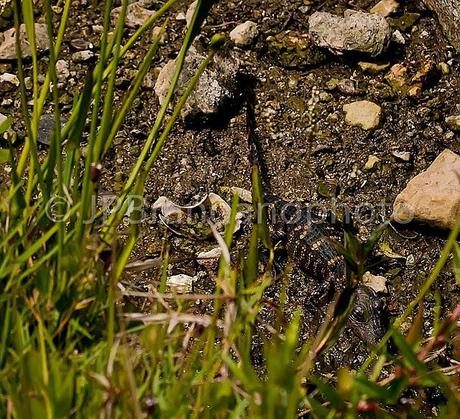 This is a young gator in a small culvert we could see from our van. It was possibly the lone survivor of a hatching that produced up to40 baby alligators. They are in danger from all kinds of predators including Great Blue Herons. We saw more of the blues in the Everglades than any other wading birds. They are there because the baby alligators provide a great food source for them. Again nature has a plan. It may sound cruel but if most of the 40 babies lived, Florida and surrounding states would be overrun by them.
This is a young gator in a small culvert we could see from our van. It was possibly the lone survivor of a hatching that produced up to40 baby alligators. They are in danger from all kinds of predators including Great Blue Herons. We saw more of the blues in the Everglades than any other wading birds. They are there because the baby alligators provide a great food source for them. Again nature has a plan. It may sound cruel but if most of the 40 babies lived, Florida and surrounding states would be overrun by them.Alligators serve an important role in the balance of nature. We need only look to Gatorland in Orlando to witness one of the many important contributions alligators provide. Thousands of indigenous aquatic birds have made Gatorland their home. Why? Because alligators protect their nests from such natural predators as raccoons and opossums. Thousands of herons and egrets, along with many threatened and endangered birds nest virtually on top of each other, because the alligators make it safer to hatch their eggs and raise their young.
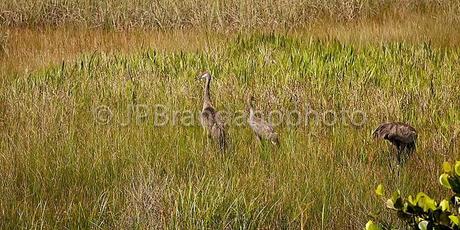
This image shows a family of Sandhill Cranes. We were told that the two adults visit the Everglades each year to have their babies.

When you look out into the Everglades from the tram, you see miles and miles of Sawgrass fields. Sawgrass is a tall plant (not really a grass) that if you looked at it closely, would reveal tiny ridges or teeth along the length of it sides. If you're not careful you could get tiny, paper like, cuts from touching it. Sawgrass is the most prominent plant in the Everglades. It can be a safe home for many species, preventing predators from reaching them easily. I think the fields are beautiful much like the fields of wheat that you see in other areas of the US. But when they are dry like they are now, it can become a fuel that feeds the fire!

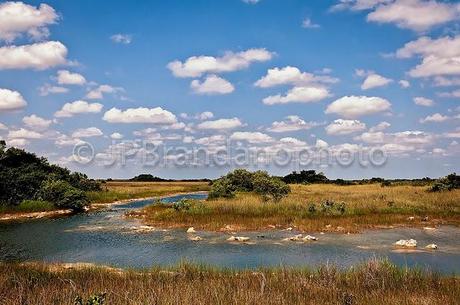
A river still runs through it.
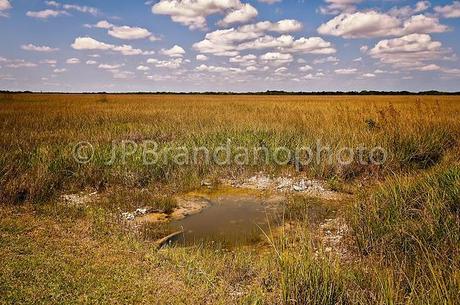
This image shows one of the small water holes along the road
which are normally much larger.
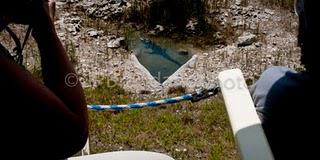
An immature alligator was spotted on the left side of the tram. You can see why we recommend getting a seat on that side of the tram, unless you happen to like silhouettes of the people who wisely sat on the left!!
 This is a Great Blue and Phyllis' silhouette. You will see a much better image of the heron when Phyllis posts her images. (Remember sit on the left!!!!)
This is a Great Blue and Phyllis' silhouette. You will see a much better image of the heron when Phyllis posts her images. (Remember sit on the left!!!!)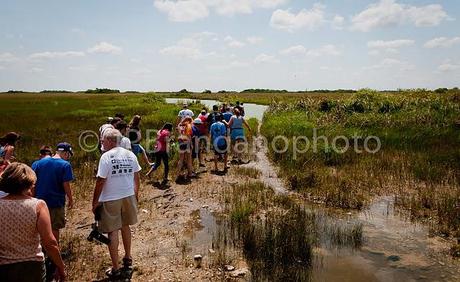 At one point the tram stopped and the ranger took people for a short walk out to a larger water hole. Bill (the ranger) was very informative and entertaining. We really recommend taking the tram ride and looking for Bill, if you can!
At one point the tram stopped and the ranger took people for a short walk out to a larger water hole. Bill (the ranger) was very informative and entertaining. We really recommend taking the tram ride and looking for Bill, if you can!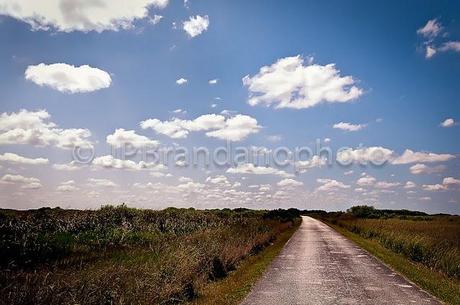 This is the tram's road between fields of sawgrass and the wonderfully blue Florida sky above.
This is the tram's road between fields of sawgrass and the wonderfully blue Florida sky above.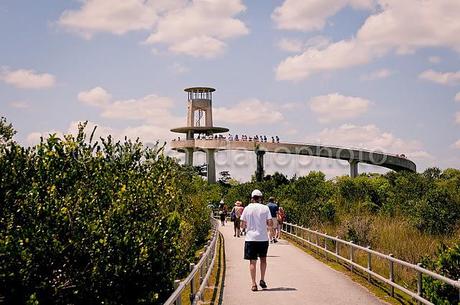
About half way through the fifteen mile loop trip, we came to an observation tower built in 1984. It spiraled skyward about fifty feet. Once on top you can see the River of Sawgrass spreading out as far as you can see.
 Phyllis climbed to the top of the tower.I really enjoyed our trip to the Everglades and will be visiting it many times. We hope that it is still there for generations to come, although we have our worries. Between the drought, threat of fire and man's encroachment on its land, the Everglades and the species that live there are in danger of surviving.
Phyllis climbed to the top of the tower.I really enjoyed our trip to the Everglades and will be visiting it many times. We hope that it is still there for generations to come, although we have our worries. Between the drought, threat of fire and man's encroachment on its land, the Everglades and the species that live there are in danger of surviving.The danger even involves people taking their pet pythons and releasing them into the Everglades. I know this sounds like a really bad movie plot but it is true. These former pets grow too large and then the owners release them into the wild where they mate and now there are pythons overrunning the park. The Burmese python is one of the worlds largest snakes.(I won't even go into what I think about these former owners! What were they thinking when they bought these snakes? Did they not understand what 20 feet was?? That's how long these snakes grow to.)
People have witnessed, on a few occasions, major battles between these snakes and the alligators. So far it appears that the alligators are holding there own but how long that is true is anyone's guess.
This is just another danger to the park and the species already endangered who live there.
WE REALLY ARE THE ENEMY!!!

